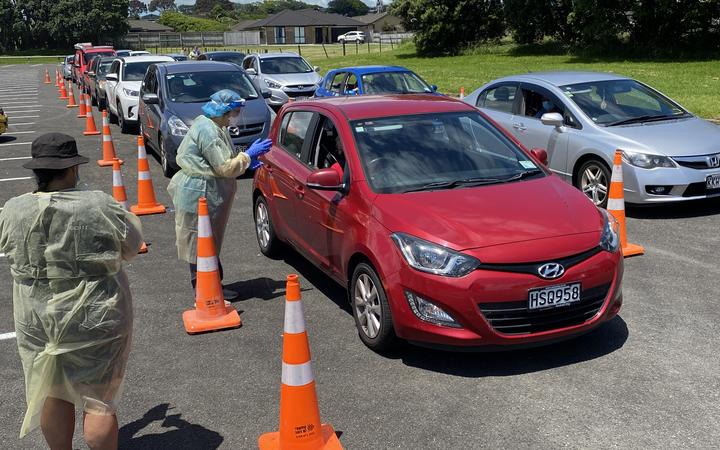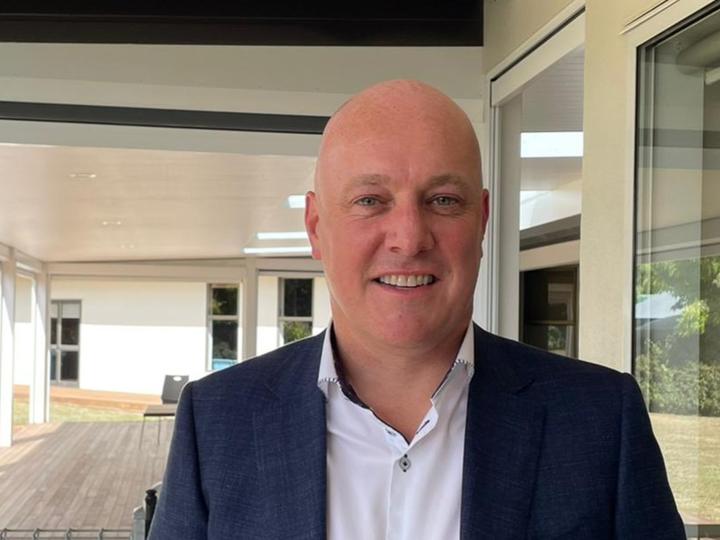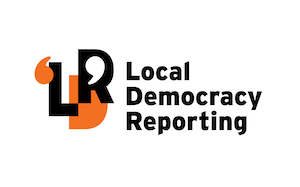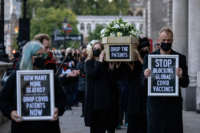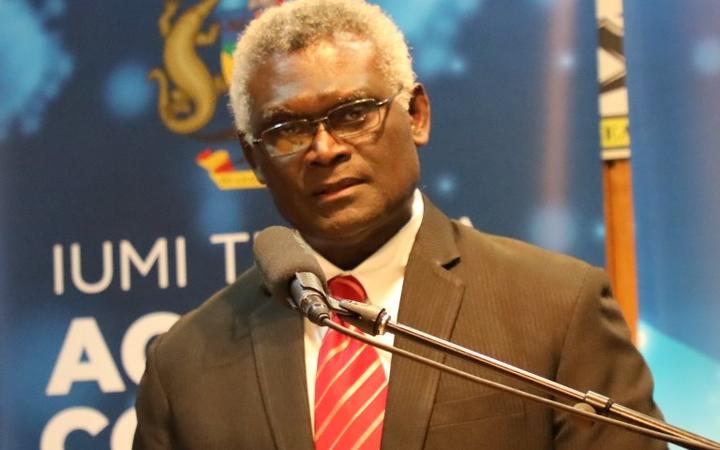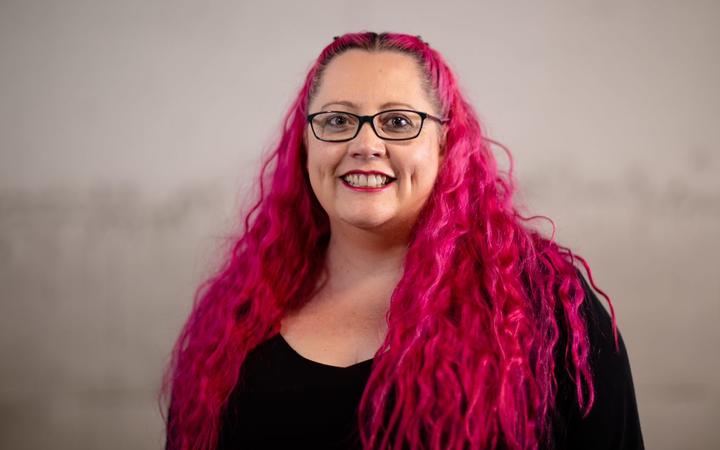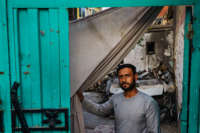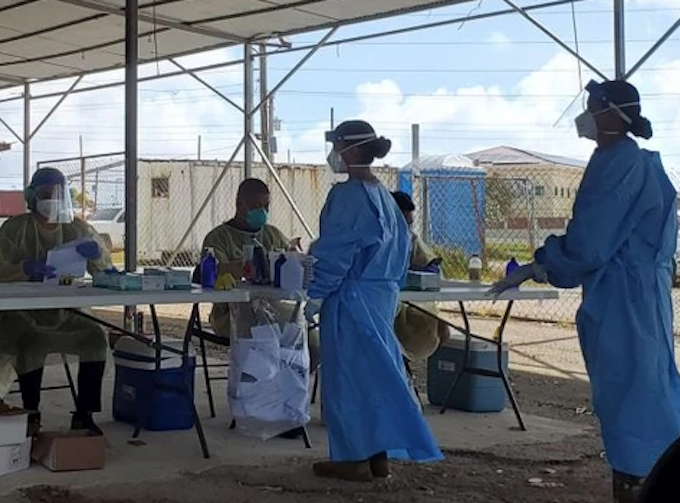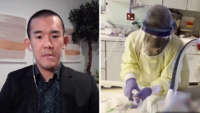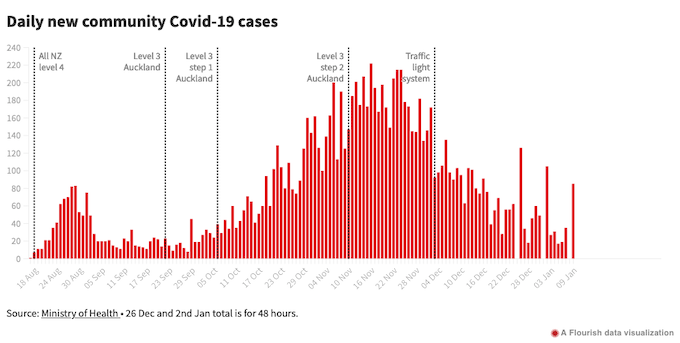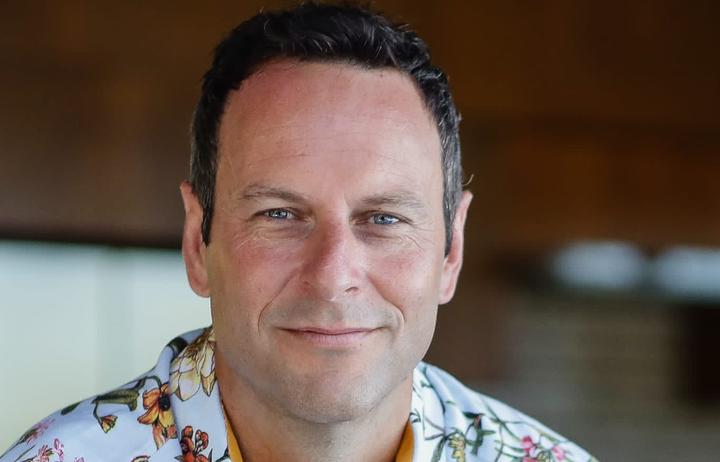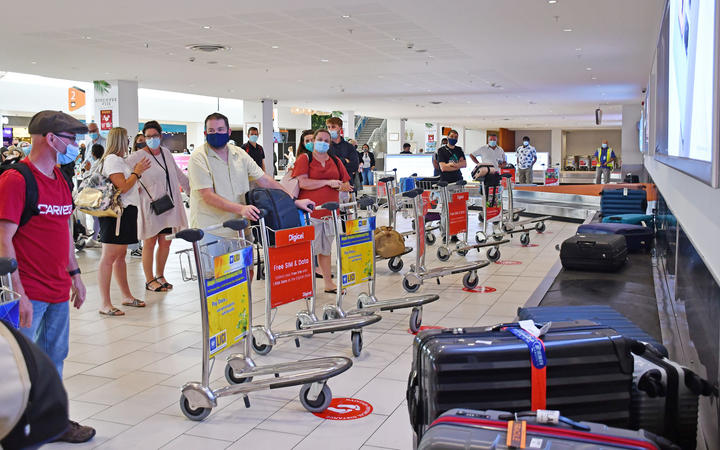The Omicron variant’s transmission rate is exponentially higher than Delta, leaving healthcare workers across the U.S. in dire straits. Waves of doctors, nurses and other health professionals are unionizing, and some have quit the profession over exploitative conditions. The staffing shortage has added on to the strains of increasing hospitalizations due to COVID-19, limited availability of necessary equipment and lack of federal support for preventative measures such as paid medical leave. “This is the cost of two years spent pushing prematurely for a return to normal,” says Ed Yong, Pulitzer Prize-winning reporter and science writer at The Atlantic. Yong also discusses the debate over keeping schools open during the COVID-19 surge, and challenges to President Biden’s vaccine mandates affecting nearly 100 million workers.
AMY GOODMAN: This is Democracy Now!, democracynow.org, The War and Peace Report. I’m Amy Goodman.
Here in the United States, nearly a quarter of hospitals are reporting critical staffing shortages as Omicron drives an unprecedented surge in infections. This comes as public schools in Chicago are closed for a fourth day as talks between the teachers’ union and Mayor Lori Lightfoot over in-person teaching remain at an impasse.
For more, we’re joined by Ed Yong, science writer at The Atlantic. He won the Pulitzer Prize for Explanatory Reporting for his coverage of the pandemic. His most recent pieces, “Hospitals Are in Serious Trouble” and “Omicron Is Our Past Pandemic Mistakes on Fast-Forward: We’ve been making the same errors for nearly two years now.”
Welcome back to Democracy Now! It’s great to have you with us, Ed. Let’s start with the hospitals. Explain the serious trouble our hospitals are in.
ED YONG: Yeah, they are at breaking point. It’s really hard to overstate how badly hospitals are faring right now. Even before the Omicron wave, they were already in trouble, because so many healthcare workers had left because of the collective traumas of the last two years of the pandemic. And now we have, firstly, a Delta wave and now Omicron on top of that. Huge volumes of patients are flooding hospitals. And while Omicron is less severe than previous variants, it’s so contagious that the sheer number of those patients is so high that there are still a lot of very sick people, and there are a lot people, full stop. So they are inundating hospitals at a time when there are fewer healthcare workers than ever before. Those healthcare workers are demoralized. They’re exhausted. And a lot of them are out sick because they have breakthrough infections from Omicron.
And all of this means that hospitals are — like, I really struggle to use the words like “crumbling,” because I don’t want to, like, exaggerate the risk, but that is what I’m hearing from people all around the country. People are waiting for six to 12 hours to get seen for any kind of emergency procedure. People in the ER are on ventilators waiting to get into ICUs, which are full. The entire system is clogged up. And it’s not just about COVID anymore. This now means that medical care for basically anything is worse than it was two years ago, because the system is just so completely flooded and unable to cope with the volume of patients right now.
AMY GOODMAN: The National Nurses United said, “Going to work should not mean putting your life and the lives of your loved ones in danger.” A group of nurses’ unions and the AFL–CIO have demanded the federal government enact permanent rules to ensure workplace safety, saying all frontline health workers should be guaranteed “personal protective equipment, exposure notification, ventilation systems, and other lifesaving measures.” Can you talk about this kind of organizing that’s going on?
ED YONG: Yeah. I think a lot of healthcare workers are fed up. Like, there’s sort of a culture, a social contract in medicine, that you sacrifice yourself for the sake of your patients. And while that contract means that the rest of us get decent medical care when we expect it, it also creates the conditions where healthcare workers are very easily exploited by society at large, as we’re seeing now, and by their own particular institutions.
So it’s no surprise, after two years of this, after feeling betrayed by the public, by a lot of places they work for, that a lot of them are starting to organize, and there’s more movement towards unions. There’s more of a sense of, like, “We just cannot take this anymore.” And I commend that. I do think, like, that’s necessary for creating a more stable medical system.
What I worry is that there are a lot of people who, rather than deciding to fight for this, have just decided, very reasonably, to stop, to leave their jobs or the profession. I’ve heard from so many healthcare workers who have already made that choice. And their decisions thin the ranks of those who are left behind to take care of the rest of us and whose jobs are now that much harder.
But, honestly, if so much of society has pretended that the pandemic is over, and has longed to get back to normal, can you really blame healthcare workers for wanting to do the same? This is the cost of two years spent prematurely pushing towards a return to normal, except, for the healthcare system, for our ability to get medical care, there might not be a normal to return to.
AMY GOODMAN: Last week, President Biden reiterated his support for keeping schools open during the COVID surge. This is what he said.
PRESIDENT JOE BIDEN: We know that our kids can be safe when in school, by the way. That’s why I believe schools should remain open.
AMY GOODMAN: I want to get your response to this, Ed. We see the Chicago schools are closed because the Chicago Teachers Union says they’re not going to expose their teachers in this way. Other schools that are remaining open around the country, like in New York, are just vectors for infection.
ED YONG: So, I sympathize with everyone on this side of the debate, right? Like, on the one hand, you have parents who are really scared about putting their children in these conditions where this extremely transmissible virus is just going everywhere. I sympathize for parents who can’t handle remote schooling or just don’t have the option to do that. I sympathize with teachers who don’t feel that they can put themselves at risk anymore. I think, though, that we’re sort of — we’ve been put in a position where we’re having to choose, we’re having to, like, take sides between people who are all in the right. Like, this shouldn’t be a debate in the way it’s framed.
The jobs of the federal government should have been to control transmission of this virus and to control the pandemic to an extent where this shouldn’t even have been an issue. And so many of the measures that were necessary — you know, the rollout of rapid tests, mask mandates — all of these things have been, if anything, got pulled back at both the federal and the state level. There’s not been enough done to control the pandemic for two years now. And last year really wasn’t that much different. Like, because our policymakers have made bad decisions, it puts individual schools, teachers, parents in an impossible position and sets them against each other, when, in fact, I think the main problem is that the policies that should have protected all of us have not been put in place.
AMY GOODMAN: So, let’s talk about what those policies should be. I mean, you’ve pointed out in your writing, for example, that when — obviously, for politicians, they want to put this behind them, so then talking about unmasking — the fact that there aren’t tests available now, though President Biden said he’s going to get half a billion out to the country, and the fact that Abbott, which makes Binax, one of the tests, destroyed millions of those tests.
ED YONG: Right, because we keep on treating this like a short-term problem. We keep on assuming that we’re going to get back to normal at some point in the near future without actually doing the work to get to that point. Rapid tests are a clear example of this. Like, why do we not have them deployed on a mass scale? Biden talks about deploying that number of tests out to people. It’s roughly like one-and-a-half tests per person.
And I also want to talk about the social measures that should have been put in place right from the start. Like, we know that a pandemic is a social problem. It’s not just a biomedical one. Yes, vaccines and therapeutics and diagnostic tests are great, but we need things that actually allow people to protect their livelihoods and their lives at the same time. And paid sick leave is a great example of this. It seems like a really weird measure to be talking about in the context of a pandemic, but if you can’t actually take the time off to isolate or to take care of yourself if you’re exposed, if your workplace conditions don’t allow you to do that, then how are you going to stop yourself from spreading this disease?
Like, we know that these things actually matter and can have an immediate impact, but they don’t seem to be part of the package of measures that we’ve been talking about. People sort of gravitate between just going on completely as normal or going to a strict lockdown. There are so many things in the middle. Like, we’ve talked about masking, we’ve talked about rapid tests, we’ve talked about paid sick leave. Ventilation is important. Having places where people can isolate is important. These kind of measures are going on in parts of the country but not everywhere, and there doesn’t seem to be any sort of federal push to really make them everywhere or to pressure states into actually putting them into place. And that is part of the problem. That is why we’re in the state where we’re having these horrendous discussions about schools and where we’re looking at a healthcare system that is collapsing under the sheer weight of infections.
AMY GOODMAN: Do you think this could lead to Medicare for All? I mean, it has exposed the fracture of the entire system, a system that was broken already in terms of who gets healthcare and who doesn’t in this country. Now it’s who dies and who doesn’t.
ED YONG: Yeah. You know, people who are unvaccinated are actually, like, the uninsured, make a disproportionate — I’m saying this terribly. A lot of people who are unvaccinated are also uninsured, right? And that says something about the medical system in this country. Like, there’s this sort of tendency to paint unvaccinated people as all like antagonistic anti-vaxxers. And I think access is still actually a large problem that isn’t really grappled with.
I would hope that the lessons from these two years are that inequities harm us. You cannot fight a vaccine — you cannot fight a pandemic properly in a grossly unequal society such as what we currently live in. But that doesn’t seem to be the lesson that is being learned. Like, we’ve had lip service paid to the need to focus on inequities, but even from, like, leading public health voices, it seems to be a thing that is readily forgotten. And that is — you know, that is part of why we are where we are now. Unless we actually make efforts to protect the most vulnerable, to help people on low incomes, people from marginalized groups, disabled communities — unless we stop treating them like disposable commodities, we’re going to end up back in this situation that we currently find ourselves in.
AMY GOODMAN: The Supreme Court hearing oral arguments around Biden’s vaccine mandates, your thoughts?
ED YONG: I worry that we are — instead of learning the lessons that you’ve just talked about, that would make us better prepared for the next one, that we are setting legal precedent in place that would actually make us more vulnerable next time ’round. And, you know, there are many different examples of this. State legislatures around the country have put in orders that make it more difficult for people to put in, say, mask mandates or quarantine orders. That contributes to how hard it is to fight something like Omicron. It is going to make it more difficult to deal the next variants. It’s going to make it more difficult to deal with the next pandemics, which I guarantee you we will face.
AMY GOODMAN: Well —
ED YONG: I worry —
AMY GOODMAN: Well, Ed, we’re going to have to go, but I wanted to wish you a happy 40th birthday. I know it was very difficult. You wrote a piece talking about canceling your 40th birthday because of Omicron.
ED YONG: Thank you.
AMY GOODMAN: Thank you so much for being with us. Ed Yong, science writer at The Atlantic, won the Pulitzer Prize for his reporting on the pandemic. We’ll link to his pieces.
That does it for our show. Remember, wearing a mask is an act of love. I’m Amy Goodman. Thanks for joining us.


